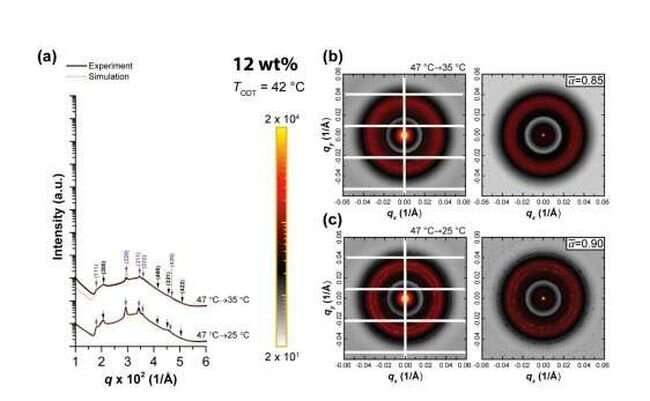Researchers transform our understanding of crystals

When most people think of crystals, they picture suncatchers that act as rainbow prisms or the semi-transparent stones that some believe hold healing powers. However, to scientists and engineers, crystals are a form of materials in which their constituents—atoms, molecules, or nanoparticles—are arranged regularly in space. In other words, crystals are defined by the regular arrangement of their constituents. Common examples are diamonds, table salt, or sugar cubes.
However, in research just published in Soft Matter, a team led by Rensselaer Polytechnic Institute’s Sangwoo Lee, associate professor in the Department of Chemical and Biological Engineering, discovered that crystal structures are not necessarily always regularly arranged. The discovery advances the field of materials science and has unrealized implications for the materials used for semiconductors, solar panels, and electric vehicle technologies.
One of the most common and important classes of crystal structures is the close-packed structures of regular spheres constructed by stacking layers of spheres in a honeycomb arrangement. There are many ways to stack the layers to construct close-packed structures, and how nature selects specific stacking is an important question in materials and physics research. In the close-packing construction, there is a very unusual structure with irregularly spaced constituents known as the random stacking of two-dimensional hexagonal layers (RHCP). This structure was first observed from cobalt metal in 1942, but it has been regarded as a transitional and energetically unpreferred state.
Lee’s research group collected X-ray scattering data from soft model nanoparticles made of polymers and realized that the scattering data contains important results about RHCP but is very complicated. Then, Patrick Underhill, professor in Rensselaer’s Department of Chemical and Biological Engineering, enabled the analysis of the scattering data using the supercomputer system, Artificial Intelligence Multiprocessing Optimized System (AiMOS), at the Center for Computational Innovations.
“What we found is that the RHCP structure is, very likely, a stable structure, and this is the reason that RHCP has been widely observed in many materials and naturally occurring crystal systems,” said Lee. “This finding challenges the classical definition of crystals.”
The study provides insights into the phenomenon known as polytypism, which enables the formation of RHCP and other close-packed structures. A representative material with polytypism is silicon carbide, widely used for high-voltage electronics in electric vehicles and as hard materials for body armor. Lee’s team’s findings indicate that those polytypic materials may have continuous structural transitions, including the non-classical random arrangements with new useful properties.
“The problem of how soft particles pack seems straightforward, but even the most basic questions are challenging to answer,” said Kevin Dorfman of the University of Minnesota-Twin Cities, who is unaffiliated with this research. “This paper provides compelling evidence for a continuous transition between face-centered cubic (FCC) and hexagonal close-packed (HCP) lattices, which implies a stable random hexagonal close-packed phase between them, and thus makes an important breakthrough in materials science.”
“I am particularly pleased with this discovery, which shows the power of advanced computation to make an important breakthrough in materials science by decoding the molecular level structures in soft materials,” said Shekhar Garde, dean of Rensselaer’s School of Engineering. “Lee and Underhill’s work at Rensselaer also promises to open up opportunities for many technological applications for these new materials.”
Lee and Underhill were joined in research by Rensselaer’s Juhong Ahn, Liwen Chen of the University of Shanghai for Science and Technology, and Guillaume Freychet and Mikhail Zhernenkov of Brookhaven National Laboratory.
More information:
Juhong Ahn et al, Continuous transition of colloidal crystals through stable random orders, Soft Matter (2023). DOI: 10.1039/D3SM00199G
Citation:
Researchers transform our understanding of crystals (2023, May 18)
retrieved 18 May 2023
from https://phys.org/news/2023-05-crystals.html
This document is subject to copyright. Apart from any fair dealing for the purpose of private study or research, no
part may be reproduced without the written permission. The content is provided for information purposes only.
For all the latest Science News Click Here
For the latest news and updates, follow us on Google News.

